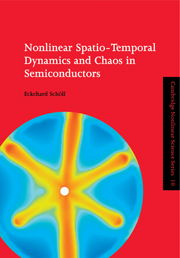Book contents
- Frontmatter
- Contents
- Preface
- Chapter 1 Semiconductors as continuous nonlinear dynamic systems
- Chapter 2 Concepts of nonlinear charge transport in semiconductors
- Chapter 3 Pattern formation and oscillatory instabilities in semiconductors
- Chapter 4 Impact-ionization-induced impurity breakdown
- Chapter 5 Nonlinear carrier dynamics in crossed electric and magnetic fields
- Chapter 6 Stationary and oscillating domains in superlattices
- Chapter 7 Spatio-temporal chaos
- References
- Index
Chapter 6 - Stationary and oscillating domains in superlattices
Published online by Cambridge University Press: 17 September 2009
- Frontmatter
- Contents
- Preface
- Chapter 1 Semiconductors as continuous nonlinear dynamic systems
- Chapter 2 Concepts of nonlinear charge transport in semiconductors
- Chapter 3 Pattern formation and oscillatory instabilities in semiconductors
- Chapter 4 Impact-ionization-induced impurity breakdown
- Chapter 5 Nonlinear carrier dynamics in crossed electric and magnetic fields
- Chapter 6 Stationary and oscillating domains in superlattices
- Chapter 7 Spatio-temporal chaos
- References
- Index
Summary
In this chapter we study vertical high-field transport in semiconductor superlattices. Depending upon the circuit conditions and the material parameters, e.g. the mean doping density ND, either stable stationary domains (for high ND), or self-sustained oscillations of the domains (for intermediate ND) are found. We shall see that this behavior is strongly affected by growth-related imperfections such as small fluctuations of the doping density, or the barrier and quantum-well widths, and that weak disorder on microscopic scales can be quantitatively detected in the global macroscopic current–voltage characteristics. The bifurcations which occur and the roles of the various realizations of the microscopic disorder are discussed, as is the dynamics of domain formation.
Introduction
In Section 2.2.1 (Fig. 2.5) it was mentioned that vertical high-field transport in GaAs/AlAs superlattices is associated with NNDC and field-domain formation induced by resonant tunneling between adjacent quantum wells. This was observed experimentally by many groups (Esaki and Chang 1974, Kawamura et al. 1986, Choi et al. 1987, Helm et al. 1989, Helgesen and Finstad 1990, Grahn et al. 1991, Zhang et al. 1994, Merlin et al. 1995, Kwok et al. 1995, Mityagin et al. 1997). Those domains are the subject of the present chapter. The field domains may be either stationary, leading to characteristic sawtooth current–voltage characteristics (Esaki and Chang 1974), or traveling, associated with self-sustained current oscillations (Kastrup et al. 1995, Hofbeck et al. 1996). In strongly coupled superlattices, i.e. superlattices with small barrier widths, oscillations above 100 GHz at room temperature (Schomburg et al. 1998, 1999) have been realized experimentally, whereas in weakly coupled superlattices the frequencies are many orders of magnitude lower (Kastrup et al. 1997).
- Type
- Chapter
- Information
- Nonlinear Spatio-Temporal Dynamics and Chaos in Semiconductors , pp. 262 - 289Publisher: Cambridge University PressPrint publication year: 2001



